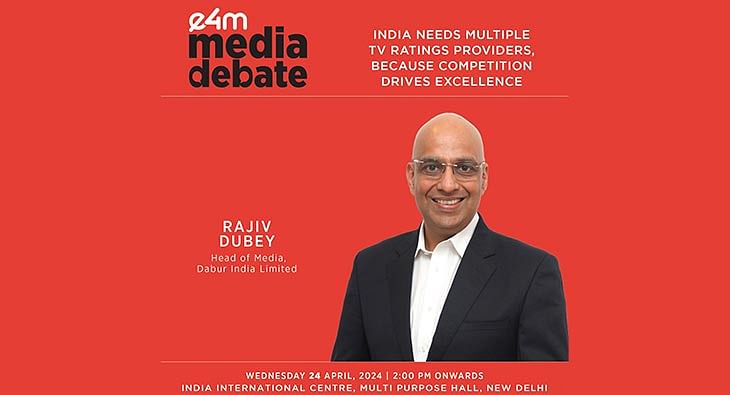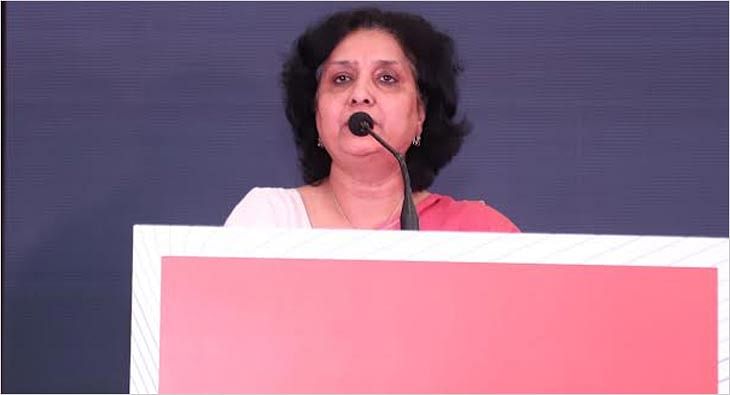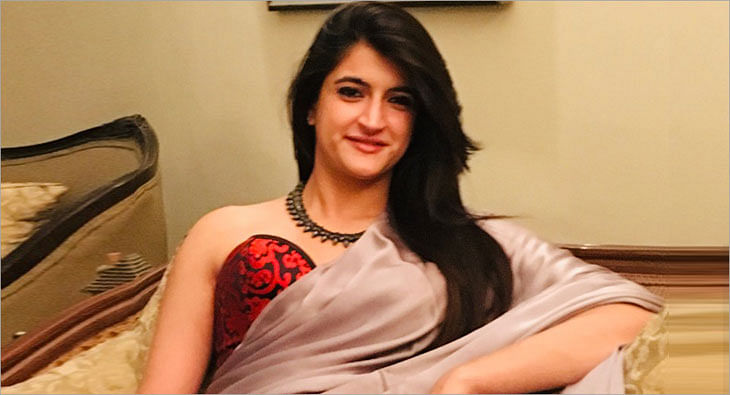Republic brings viewers the on-ground story on Covid with 'Stay Strong India' campaign
The campaign's working towards a combined win against the ongoing Pandemic by showcasing all sides of the story, along with bringing verified and latest information on Covid from experts
Republic Media Network since the onset of the Second Wave of COVID-19 has dedicated 100% of its programming on the Nation’s fight against COVID. Republic’s #StayStrongIndia campaign has become a viral chorus across the globe, a worldwide expression of solidarity, a symbol of India’s resolve and one that has rallied Indians to come together to defeat COVID-19.
Republic Media Network’s “Stay Strong India” campaign is rooted in sinking our old differences, our varied ideologies, as a Nation and working towards a combined win against the ongoing Pandemic. The campaign of the Network has made it a point to showcase all sides of the story and not just the doom and gloom that crores of Indians are battling daily. Verified information with experts, questions answered by the biggest names in the medical fraternity, worldwide network exchanges with inputs on the soon-to-be imported vaccines, ground reports from every city and town and breaking alerts on every development and guideline has been just a glimpse of the programming on Republic TV. The core focus of the campaign has been to ensure a solution- based approach and not stoke panic; to become an information and news headquarters for COVID-19 so that every Indian — in India or abroad— has the right to verified information and combined solutions.
Some of the aspects of Republic’s #StayStrongIndia campaign are as follows:
- A special primetime show at 6pm daily dedicated coverage on one crucial subject linked to Covid-19. In this show, experts and the top names from the medical fraternity come together to answer the questions from viewers on a particular aspect of COVID-19. The dedicated programming has seen an overwhelming response and directly connects the citizens in a Pandemic to the expert voices that have answers based on experience, science and facts.
- Special interviews with game changers and trailblazers in the fight against COVID - from COVID heroes to medical experts to app creators to policy makers to foreign and Indian vaccine makers and ministers across India: Daily interview segments with the biggest newsmakers in India’s COVID-19 fight are on Republic.
- Daily coverage of not just the points of concern but also the points of hope on how India is uniting to fight COVID. The data that matters is the data on the Republic, as we battle to bend the curve.
- Stay Strong India is also about holding the system accountable. Republic’s Special Investigative Team
has been filing deep investigative reports on critical shortages and unscrupulous activity across the country and holding the system accountable to drive on ground change, so that maximum resources reach those who most need it.
- Live interactive special shows connect citizens directly to medical experts to answer COVID queries, which in turn has ensured Republic is the voice and destination of the people at a time when we battle our toughest crisis.
- Republic TV is the only English News Channel to go to the heart of rural India and bring live reports of the COVID situation in these otherwise forgotten and ignored rural regions. In a special 5 minute recurring daily segment, Republic TV beams the visuals of what is happening in our villages and small towns.
- In a special segment on ‘My Vaccine Story’, Team Republic vlogs its vaccination process, from the time of reaching the vaccination centre to getting the jab, it breaks the hesitation around vaccination.
- The Network has ensured 100% ground coverage by Republic Reporters from hotspots to detail the ground situation.
- Republic TV under the banner of Stay Strong India has dedicated its Super Prime Time debates to COVID-related issues.
Republic Media Network’s Editor-in-Chief Arnab Goswami on the ongoing #StayStrongIndia campaign said, “ Yes these are the most difficult of times. They have frustrated us and challenged us. They have taken us to the depths of loss and despair. And yet in these times most of all we must believe that we will overcome. We will turn things around together. We will not give up and not let anything stop our fight back. Because when history is written India will rise by fighting its biggest battle in decades. We will rise. Only India can. Only India will. We will.”
The campaign of Stay Strong India has reverberated across the globe. With landmark buildings including Burj Khalifa, in Dubai and the Adnoc headquarters in Abu Dhabi lit up with the message "Stay Strong India", it is clear that the campaign has resonated across the world. Diplomats and leaders from all over have been using the hashtag - whether it is the UAE or Israel, thereby standing strongly with the resolve of this great nation.
Republic Media Network is committed to get its 300 million viewers across India the real picture, first-hand stories, accurate details, and sharp analysis on what's working and what's not. No part of India will be unchartered as Republic brings its viewers the on-ground story. That is the purpose of this campaign. Our resolve is only and only to come together and ensure India wins.
India will win.
Read more news about Television Media, Digital Media, Advertising India, Marketing News, PR and Corporate Communication News
For more updates, be socially connected with us onInstagram, LinkedIn, Twitter, Facebook Youtube, Whatsapp & Google News
The current ratings system lacks trust: Rabindra Narayan, PTC Network
During the recently held e4m media debate, Rabindra Narayan, MD and President, PTC Network, spoke for the need for multiple TV rating providers
The current system of ratings by BARC lacks trust and credibility, said Rabindra Narayan, MD and President, PTC Network, at the e4m debate on Wednesday while asserting the need for multiple rating agencies in the broadcast ecosystem.
The e4m media debate on ‘India needs multiple TV rating providers because competition drives excellence’, held in New Delhi, was chaired by Anurag Batra, Founder of e4m and Editor-in-Chief of Businessworld Media Group.
During the debate, Narayan, who was speaking for the motion with other panellists, questioned the Broadcast Audience Research Council (BARC) ratings, particularly for news channels saying that politicians spending money to advertise on news channels and not GECs, is proof enough that the genre is doing much better than the ratings given by BARC.
“The fact that we are having this discussion, implies that the current system lacks trust. It lacks credibility. BARC analyses only linear TV that is beamed and received through satellite and cable. TV viewing today is not just linear TV, it also has several forms like connected TV and Fast TV coming on the same screen but BARC is not measuring it,” he said.
Narayan further said that it was time to innovate and look at content rating rather than just television rating points.
“As per BARC, news genre reach is 6-7% in the entire country, if that is true then why are politicians eager to spend on advertising on news channels? Why not on GECs? Why all the money spent by advertisers to reach maximum consumers, based on this Bible (BARC) which is junk? Why are we fighting for TV rating points and not content rating points when the technology and the system is changing?
“The current system of ratings (by BARC) is flawed, biased as it is controlled by a handful of people. Broadcaster lobby is controlled by four business houses so it will always remain in their favour. The data shows it,” he argued.
In his concluding remarks, Narayan said that BARC needs to improve and for that it does not even need to invest in more meters than it already has because cable operators and DTH are now digitised.
“They don’t even need to invest more. They don’t even need more meters than the ones installed already because every cable operator is now digitised and has two-way addressable communication available,” he said.
e4m Media Debate 2024: Call for multiple ratings agencies to break monopoly
Industry players discussed the authority of the current ratings system and whether having multiple agencies will cause increased complexities, discrepancies and expenses
Indian TV news media and advertisers today rely solely on the data released by the Broadcast Audience Research Council (BARC) India to strategise media plans and budgets.
Hence, many suggest having multiple rating systems which will allow for a more nuanced understanding of viewership patterns across different demographics.
Rabindra Narayan, MD and President, PTC Network; Mona Jain, Chief Revenue Officer, Zee Media, and Karthik Sharma, Group CEO, Omnicom Media Group believe a multi-ratings system will drive excellence amidst competition.
On the other hand, multiple ratings systems may also present challenges such as increased complexity, potential discrepancies in ratings, and higher costs for broadcasters as well as advertisers.
The current system of ratings is “flawed” and “biased, as it is controlled by a handful of people,” was the view of the industry veterans who advocated the need for multiple rating agencies instead of just one, which is currently the BARC, saying “monopoly makes people complacent”
During the debate, things got intense when some of the panellists, who were speaking for the motion, questioned BARC ratings, particularly for news channels saying that politicians spending money to advertise on news channels and not GECs, is proof enough that the genre is doing much better than the ratings given by BARC.
To present a viewpoint against the motion, Chintamani Rao, Strategic Marketing and Media Consultant, Rajiv Dubey, Head of Media, Dabur India, and Varun Kohli, Director and CEO, Bharat Express News Network joined the debate at e4m’s Media Debate in New Delhi. Dr. Annurag Batra, Chairman and Editor-in-Chief, BW Businessworld Media Group and Founder, e4m Group, chaired the debate.
Jain opened the discussion and said, “There is a dependency of an advertiser to take up a particular media plan via the agency. On the other hand, the broadcaster is absolutely at the mercy of the measurement system which decides where you rank. The issue is nobody looks at what the reality on ground is. Hence, I have started telling agencies and advertisers to also look at my digital platform’s ranking but the rating in BARC still holds significant value for them.”
She further suggested we should have an authenticated, validated, acknowledged currency which is recognised and valued by advertisers and agencies as well.
Presenting an opposing stand, Rao explained, “There many doubts about BARC and its functioning but I continue to maintain that audience measurement is no business of the government.”
At the end of the day, it is not about the number of vendors but how they are managed. Two poorly managed are not better than one, he added. The key issue is that BARC is dominated by one of its constituents and that is the one which is being measured.
“If advertiser’s money fuels the entire media ecosystem, why did they accept a structure with Indian Broadcasting & Digital Foundation (IBDF) at 60 percent?” questioned Rao.
Sharma, who joined virtually, expressed that if we forget the industry for a while, why do we need the NSE and BSE? Why do we need CIBIL and Experian? The short answer is innovation and competition. If there would be no competition, we would have one brand in every category we operate in.
“Even in a market like the USA, which has the largest AdEx market, there are two systems. Even the UK, Australia, Malaysia, Philippines and so many more countries have two audience measurement systems. In a largely populated country like India two systems will help in better sampling and segmentation,” he added.
Dubey took the stage right after and spoke about how one, two or multiple rating systems don’t matter to an advertiser. At the end of the day, it should help the brand sell. His objective is to reach out to the consumers in the cheapest possible manner.
“The idea of BARC was to have a robust system which could measure everyone well. Have we been able to do that? Probably yes or probably no,” he said.
With changing times, the audience needs have changed and NCCS was a system that measured the class of people based on the ownership of consumer durables. But now, the newly proposed ISEC fulfils those gaps.
Consumers have also started consuming content on different platforms, more towards digital and OTT. Dubey believes, “We haven’t been able to measure that audience correctly yet. Hence, the Indian TV industry needs one system and that system needs to be strengthened in such a way that it measures TV and digital audience equally.”
On having multiple audience measurement systems, the Dabur spokesperson said, “To solve the problem, you should not create another problem, but fix the problem instead.”
Narayan of PTC, who stood for the motion, expressed, “The fact that we are standing here and debating the issue, implies the current system lacks trust and credibility. We are also setting the premise that by TV ratings, we only mean linear TV ratings because that is what BARC does.”
He further shared that BARC does measurement via image mapping and hence, when any channel puts its watermark on any platform, it should become measurable for BARC since they already have the technology for it.
“Then why don't they? Because they need more focus on analysis, not more investment. The trouble is the ecosystem is not allowing the expansion of those ratings,” he added.
Today, BARC says 9 out of 100 people watch PTC, which is impossible and advertisers bargain for the ad rates accordingly. The channel today continues to invest in good shows but advertiser interest is low due to BARC’s data. If there is any truth to this, why wouldn’t players like PTC fight for multiple ratings systems?
“When Chandrayaan was launched, everyone in the world and India was watching it but if you see the BARC data, that particular week the ratings of the news genre went down. Is that even possible? News genre is much higher than what BARC is projecting,” Jain added.
Even on a day like the launch of Chandrayan, there was no spike on BARC data. Jain and Narayan both believe the current system is flawed and biased because it is controlled by a handful of people.
“The fact that we are having this discussion, implies that the current system lacks trust. It lacks credibility. BARC analyses only linear tv that is beamed and received through satellite and cable. TV viewing today is not just linear tv, it also has several forms like connected TV and Fast TV coming on the same screen but BARC is not measuring it,” Narayan said.
Narayan further said that it was time to innovate and look at content rating rather than just television rating points.
“As per BARC, news genre reach is 6-7% in the entire country, if that is true then why are politicians eager to spend on advertising on news channels? Why not on GECs? Why all the money spent by advertisers to reach maximum consumers, based on this Bible (BARC) which is junk? Why are we fighting for TV rating points and not content rating points when the technology and the system is changing?
“The current system of ratings (by BARC) is flawed, biased as it is controlled by a handful of people. Broadcaster lobby is controlled by four business houses so it will always remain in their favour. The data shows it,” he argued.
Kohli of Bharat Express, said, “BARC came into existence because publishers wanted a different rating system and then a mechanism was conceived. Now, questioning that system just because ratings aren’t in the right proportion or it doesn’t map digital audiences and to further ask for a separate body, I dont think is the right way.”
The industry needs to come together and exercise jurisdiction with BARC to tell them what more is needed and where they can get better, he suggested as a solution.
Rao also suggested it is better to have an aggregator rather than multiple players. In that case, the aggregator can also become the provider of data. BARC can always collect multiple data from various sources and present it.
The mapping of the audience correctly will also solve the problem in a way, which will be done with ISEC majorly. Having a unified measurement is also another solution, said Dubey.
According to Sharma, “Having more than one player will definitely fuel innovation and have a little competition, which is good. Different rating systems could also focus on different target segments, cohorts and more.”
“We need to focus on screens and not linear tv or digital. It is a screen-based world and people are just consuming content which is meaningful for them. So different types of consumptions require different types of measurements. My argument is innovation is critical as it is high time.
“Consumer is looking at the screen through mobile or TV sets. How are we measuring it? Some competition is healthy. It is important to have a mindset of how one system can help the other. The current system is not wrong but the newer system can enhance what we have,” he said.
Narayan concluded, “Television viewing and consumption has changed. Either BARC grows up to the changing times or others should come in and fill the gap. The market forces will decide who will remain and who will go, whose data is authentic and whose is not. There is no need for a debate here.”












 Share
Share